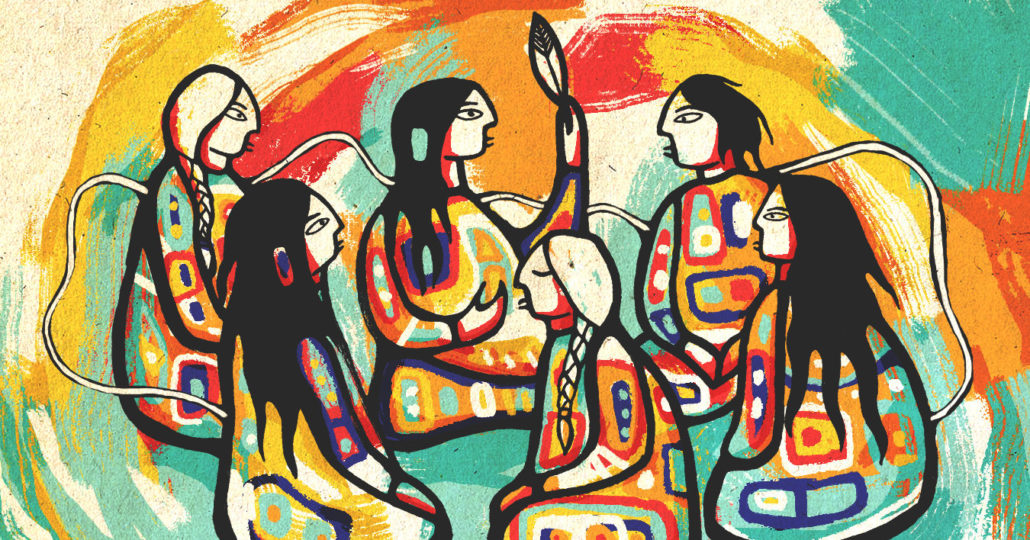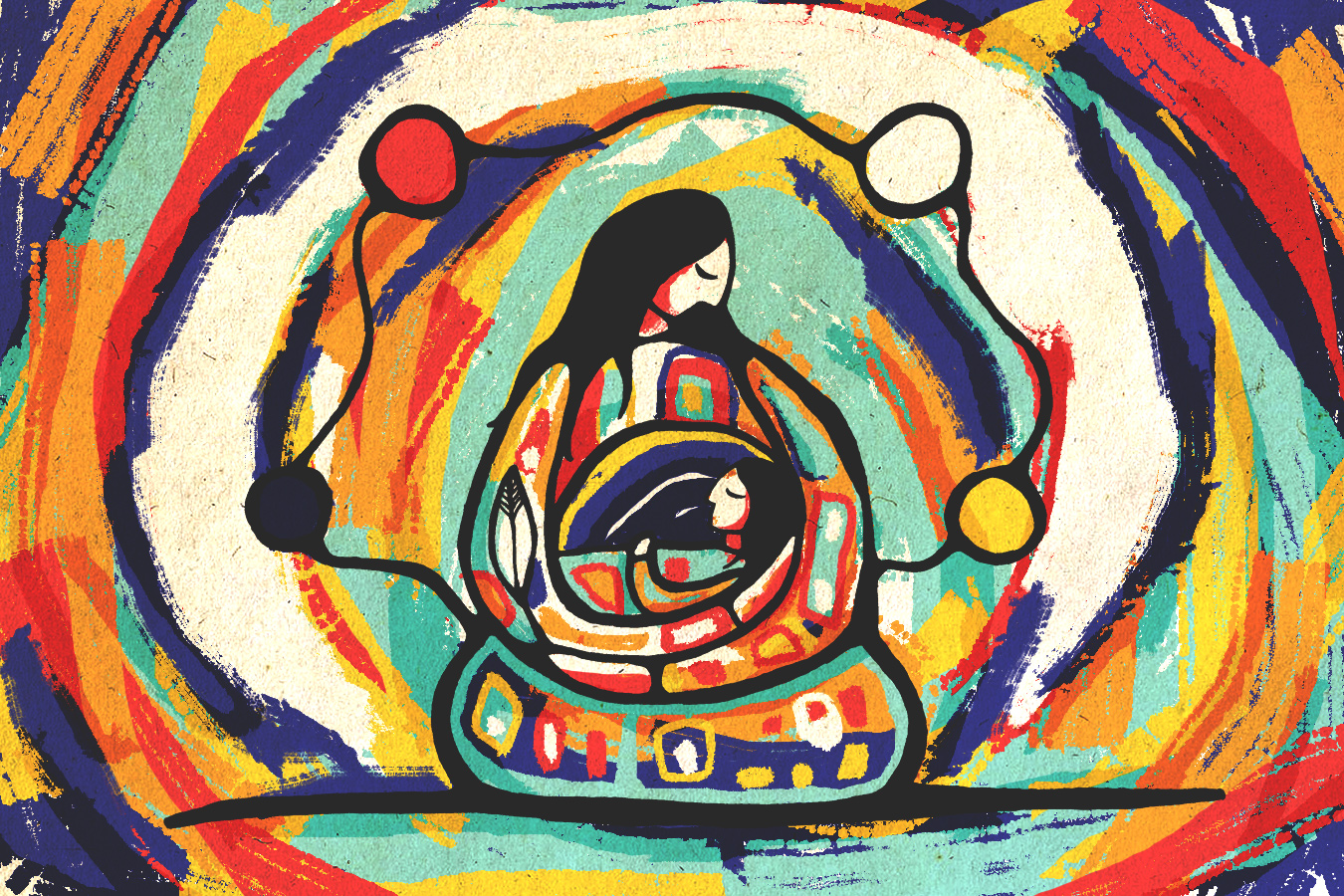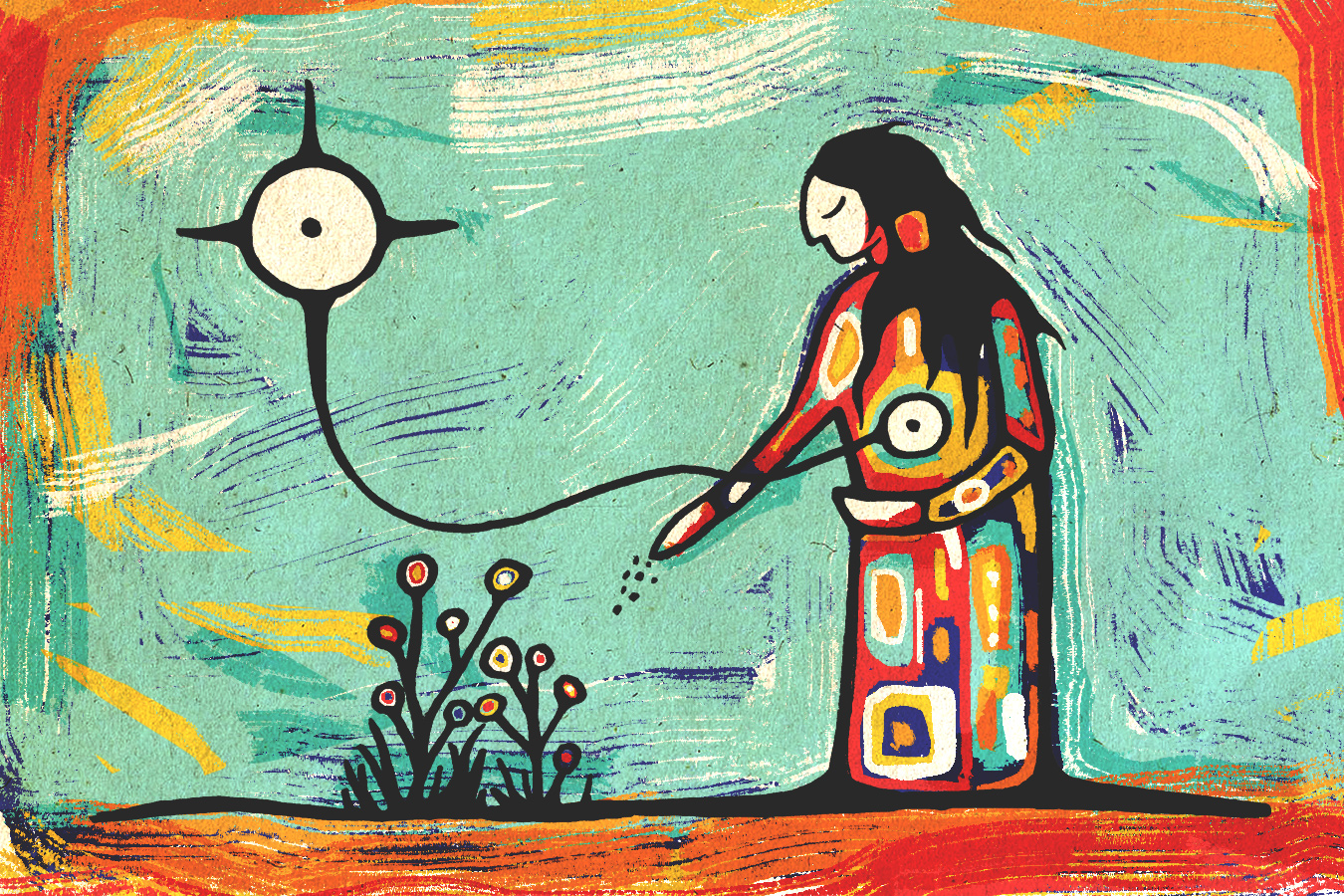
Often misunderstood, these centres offer vital cultural and spiritual connections
In the mid-to late 1990s, Patti Pettigrew, of the Algonquins of Pikwakanagan First Nation, spent a year on the West Coast attending healing circles. She was then working as a counsellor at the Downtown Eastside Women’s Centre in Vancouver, and women had started disappearing at an alarming rate. In her 40s at the time, Pettigrew was dealing, on a personal level, with some of the very issues she was trying to help her clients address – addiction included. “The things that happened when I was in the circle are very, very private,” Pettigrew relates today. “But I will say that at a very, very deep level, I experienced my healing.”
These circles are safe havens, where people can bring their trauma and hurt, and learn from Elders. Often led by a facilitator, healing circles are intended to realign a person’s physical, emotional, mental and spiritual elements. It’s the spiritual piece that sets them apart from most other group treatments—it creates a powerful connection to culture and identity that has often been missing for participants.
That year attending healing circles helped Pettigrew make sense of what has been broken inside her and figure out what she needed to feel whole. When she returned to Toronto, she felt ready to pick up her life again. But as the months passed, she noticed there was not the same level of attention to healing in this city as on the West Coast, and she could see that it was impacting people for the worse.
Pettigrew also noticed that, in the Greater Toronto Area, there were scarcely any opportunities for Indigenous people exiting the justice system and in recovery to connect with their culture. This was brought into stark focus when she started running the drug and alcohol program at the Elizabeth Fry Society for women involved in the criminal system. Her Indigenous clients shared that they didn’t feel comfortable, seen or supported in the halfway houses where they were residing. Non-Indigenous staff and peers lacked the most basic understanding of their culture and spirituality. It then occurred to Pettigrew that a healing lodge could provide the cultural and spiritual components these Indigenous women needed to re-integrate into society in a holistic way.
Today Pettigrew is president of the board of the Thunder Woman Healing Lodge, a planned temporary residence for Indigenous women, which will offer programming to address the historical and systemic issues that see them ending up in courtrooms in the first place. In the summer of 2019, after an uphill battle with the city and concerned neighbours, the lodge was approved for construction in Scarborough.
“There were people who were opposed to it because they didn’t understand it,” Pettigrew says. They cited concerns about safety and an overconcentration of services in the area for vulnerable people. To convince the city to green-light the project, Pettigrew had to address racism and NIMBYism, including fears that non-white criminals would move into the neighbourhood and make property values drop.
There is a lot to untangle in the public understanding of healing lodges. But according to their proponents, those that are created carefully and managed well can help undo some of the damage of the cultural genocide Indigenous people have faced since colonization began.
What is a healing lodge?
Google the term healing lodge, and you’ll see it defined in a colonial context as a correctional institution designed to meet the needs of Indigenous inmates. In 1992, Corrections Canada started creating healing lodge prisons to help return Indigenous inmates back to society after they served their sentences. The first healing lodge was proposed in 1989 by a group of Indigenous women, among them activist Sharon McIvor. They believed Indigenous inmates would benefit from cultural and spiritual reconnection, through activities such as drumming, dancing, participating in lodge ceremonies and talking with Elders, outside of the traditional prison complex.
In 1995, Saskatchewan’s Okimaw Ohci opened. It was the first women’s healing lodge with an all-women staff. While it still exists today, the eventual addition of male staff and bureaucratic rules scuttled the original vision, says Independent Senator Kim Pate, a long-time advocate for prison reform.
There are now nine healing lodges in Canada—four run by Corrections Canada for people who are still serving time, all of them extensions of colonial prisons, Pate says. These are classified as Section 81 institutions. The other five are run by Indigenous organizations that have signed a Section 84 agreement with the government, allowing women to do this healing work while transitioning back to society on probation or parole. (Once Thunder Woman Healing Lodge has been built in Scarborough, it will be the first of its kind in Ontario.) But for Indigenous people, a healing lodge is not meant to be a tool of incarceration—it’s intended to be a place of gathering, where healing circles happen.
“Our first healing lodge is the land, the Earth,” says Grandmother Sherry Copenace of the Ojibway community of Onigaming, who does spiritual work with Anishinaabe women and girls in Ontario. She adds that healing lodges take many forms: There can be lodges for men, for women and for all. There are teaching lodges, lodges for women during their moon time (menstruation) and purification lodges, otherwise known as sweat lodges. Healing lodge traditions and practices also vary across Indigenous cultures. But they all have one thing in common, which is the healing the lodges give.
The penal system’s healing lodges are still very much a colonial response to incarceration, in that they fail to honour treaties and continue to disrespect Indigenous women by upholding the Indian Act, says Sandra DeLaronde, who was co-chair of the MMIWG Manitoba Coalition and has spent 17 years working in Manitoba’s court system. (The Indian Act—federal legislation concerning the registration of First Nations people and the management of bands and reserves—for decades, until 1985, denied many First Nations women Indian status if they married a man who was not registered as a status Indian under the Indian Act, and the intergenerational effects linger.) “If you give women the opportunity to raise their children or to live in community or to have real economic security, that’s a threat to the system. When we have people regain a sense of themselves and confidence, then we can talk in real ways about reconciliation.”

What exactly happens in a correctional healing lodge?
Correctional healing lodges are different from traditional prisons because of their programming. While they were created primarily for Indigenous inmates, they are open to others, so long as they pledge to participate fully in ceremonies and practices.
Residents are expected to attend morning circles, led by an Elder, which involve a smudging ceremony and traditional teachings. They also have access to employment training and counselling, sweat lodges and pipe ceremonies. Pate, however, is concerned that women are forced to attend circles and programming in these lodges, even if they’re on their menstrual cycles, which actually goes against some Indigenous teachings.
At Buffalo Sage Wellness House, a federal correctional facility for Women in Edmonton operated by Native Counselling Services of Alberta, residents pass a feather around in a talking circle as they discuss the traumas in their life, as a way of connecting with their inner child. “The work that we do in the warrior program is very intensive,” says warrior program manager Patti LaBoucane-Benson in a 2016 promotional video. “We liken it to peeling back the layers of an onion: We expose different things that have happened in our lives through group work and discussion.” In the same video, a resident named Rosella says incredulously that the best thing that happened to her was going to jail – it’s where she found her culture.
The plan for Thunder Woman’s residential lodge, in Scarborough, is to women eligible for parole who demonstrate their commitment to the healing program, Pettigrew says. The women will receive individual counselling, addictions counselling and basic life-skills classes about things like banking, sticking to a routine and how to make carefully considered decisions.
“Everything will be done in a circle,” Pettigrew says. Community is at the heart of all the work done at the healing lodge. Thunder Woman will also have 12 transitional apartments for Women who are out but still need some support. The hope is to eventually have a storefront or gallery so women can get to work experience, too, Pettigrew says.
Why are healing lodges controversial?
Healing lodges are controversial to Indigenous rights activists because the Corrections Canada model continues to uphold the institutional racism of colonization. “We’ve had more than 20 years of oppressive correctional management,” Pate says. “For many people it’s hard to imagine doing it differently.” The model has been and continues to be, she says, “power and control” rather than community support outside of the walls of prison.
The existing healing lodges also lack the specific regional programming that will truly help inmates connect with their cultures, DeLaronde says. A Mi’kmaq woman isn’t going to connect with her spiritual identity learning a Lakota sun dance.
Healing lodges are also controversial to certain non-Indigenous people—who typically lack a real understanding of what happens inside their walls—because they sound like a nicer place for a criminal to be than a cinder-block cell.
In the fall of 2018, convicted child killer Terri-Lynne McClintic was transferred from a women’s prison to Okimaw Ohci, that original women’s healing lodge. This stoked outrage both from the public and from the father of Tori Stafford, the girl she murdered. McClintic, who is not Indigenous, has since been sent back to an Ontario prison, but her stint in the lodge remains perplexing to many.
Some people don’t believe that the residents in healing lodges are even incarcerated. At the time of the McClintic controversy, Ontario Premier Doug Ford tweeted that he had spoken with Stafford’s father and ensured him McClintic would be “brought back to jail.” Pate tweeted a reply: “Okimaw Ohci is a prison. Anybody transferred there is still in prison.”
The perception that going to a healing lodge constitutes getting a lighter sentence is also flawed. “It’s not about being soft or making things easy for the men and women who’ve been sentenced,” Howard Sapers, former correctional investigator of Canada, told CTV’s Power Play in September 2018. “It’s all about providing an opportunity so that society will be better off for this sentence.” Doing intensive healing work can be extremely difficult, says Pettigrew, who also works with Aboriginal Legal Services in Toronto. It involves facing painful parts of your past and taking personal and cultural accountability.

The case for healing lodges
Indigenous women have a birthright to their creation stories and to deep spiritual knowledge, says Copenace. “Healing lodges can help you become aware of what has hurt you in your life, and can help you get through that and be able to live a holistic life,” she says. “It’s up to us now to give people who are struggling or have challenges every opportunity to know who they are as Indigenous people, whatever nation they come from and whatever healing lodge has been gifted to their people.”
While more independent research needs to be done, some federally funded reports suggest that women who serve some of their time in a healing lodge are less likely to reoffend. A federal government backgrounder from 2013 stated that inmates who completed programming at three Indigenous healing lodges had a six percent recidivism rate—significantly below the national rate of 11 percent. A 2011 Corrections Canada review of the healing lodge system found that women and men in healing lodges were more likely to attend programming than inmates in the conventional prison system, and came away with stronger knowledge of their culture and identity.
These opportunities should be more widely available than they are, DeLaronde points out. “Healing lodges can help support Indigenous women, but, on the other hand, women shouldn’t have to go to jail to learn about their culture,” she says.
In the meantime, Pettigrew asks people to consider the alternative—having Indigenous women who have been incarcerated re-enter society without support or regard for the reasons they have been in trouble with the law to begin with (poverty, cultural genocide, abuse, etc.). Indigenous people are massively overrepresented in prison: They constitute three percent of the population in Canada, but 24 percent of the prison population. Roughly 40 percent of federally incarcerated women are Indigenous, a figure that has more than doubled since 2004, according to the Annual Report of the Office of the Correctional Investigator 2013-2014.
“I do understand people’s fears and their concerns,” Pettigrew says. “But those fears are not being relieved by women being locked up and not getting any programming. They’ll get released some day, and are they going to have changed? No.” The new lodge in Scarborough will be a game changer for the women who go there, she adds. “It will increase their self-esteem. It’s not like leaving an institution and going into another kind of institution. It’s more like coming home.”